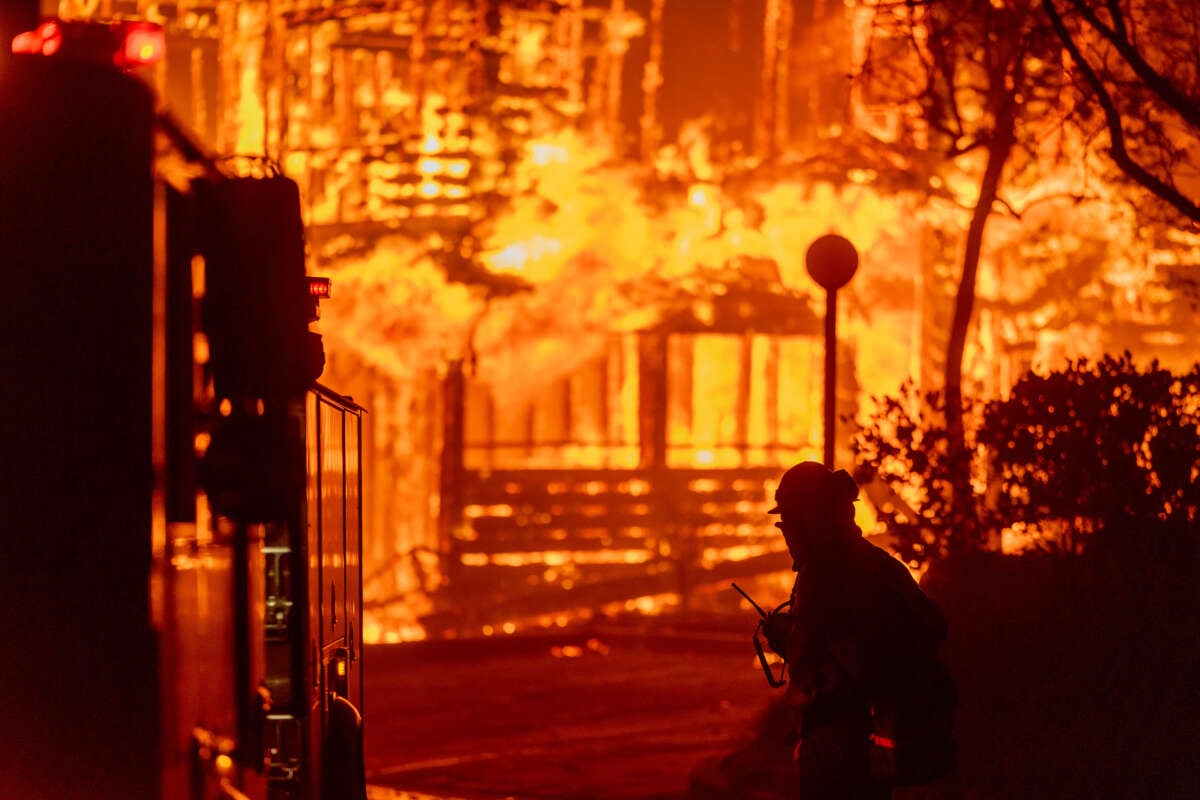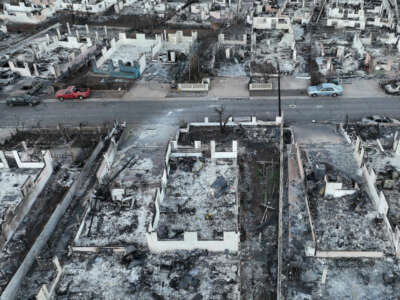The effects of the climate crisis appear to be making California wildfires more destructive.
By Chris Walker ,
January 8, 2025

Firefighters battle the Eaton Fire in strong winds as many homes burn on January 7, 2025, in Pasadena, California.David McNew / Getty Images
Honest, paywall-free news is rare. Please support our boldly independent journalism with a donation of any size.
The wildfires in southern California, which have so far resulted in thousands of acres burning in and near Los Angeles, will likely go down as among the most destructive fires the state has ever seen in terms of property damage.
Wildfires in the Pacific Palisades, Eaton and Hurst are threatening the lives of tens of thousands of people in the area. In Palisades specifically, a large neighborhood in western Los Angeles, over 5,000 acres have been burned as of Wednesday morning.
The fires have had a devastating impact, leaving at least two people dead and others injured. Around 80,000 residents in the Los Angeles area are already under mandatory evacuation orders, and in Malibu, officials are urging residents to make evacuation plans now rather than wait for an order later on. Theme parks in the area are closed until further notice.
“Evacuate now, especially if you need extra time,” the city’s official account on X advised.
Los Angeles Mayor Karen Bass is warning that conditions will get worse before they get better, citing strong winds that have been plaguing the region during the wildfires that don’t show signs of slowing anytime soon. Several counties in California are under “red flag” warnings, meaning critical fire conditions are occurring, including fast and strong winds and warm temperatures. Wind gusts are reaching as high as 99 miles per hour. The National Weather Service is describing the situation as “extremely critical fire weather.”
Related Story
Honest, paywall-free news is rare. Please support our boldly independent journalism with a donation of any size.
The wildfires in southern California, which have so far resulted in thousands of acres burning in and near Los Angeles, will likely go down as among the most destructive fires the state has ever seen in terms of property damage.
Wildfires in the Pacific Palisades, Eaton and Hurst are threatening the lives of tens of thousands of people in the area. In Palisades specifically, a large neighborhood in western Los Angeles, over 5,000 acres have been burned as of Wednesday morning.
The fires have had a devastating impact, leaving at least two people dead and others injured. Around 80,000 residents in the Los Angeles area are already under mandatory evacuation orders, and in Malibu, officials are urging residents to make evacuation plans now rather than wait for an order later on. Theme parks in the area are closed until further notice.
“Evacuate now, especially if you need extra time,” the city’s official account on X advised.
Los Angeles Mayor Karen Bass is warning that conditions will get worse before they get better, citing strong winds that have been plaguing the region during the wildfires that don’t show signs of slowing anytime soon. Several counties in California are under “red flag” warnings, meaning critical fire conditions are occurring, including fast and strong winds and warm temperatures. Wind gusts are reaching as high as 99 miles per hour. The National Weather Service is describing the situation as “extremely critical fire weather.”
Related Story

Record-Breaking Heat, Wildfires and Storms Globally Linked to Climate Change
In 2023, record-high sea temperatures increased hurricane intensification, raising the risk of more destructive storms. By Beth Daley , TheConversation December 31, 2023
“For some context, fire crews are up against near hurricane-force winds occurring mid-winter in rugged terrain during a drought at night,” explained meteorologist Eric Holthaus, discussing work to contain the fire overnight. “There is no ‘firefighting’ in these kinds of conditions. There is only saving as many lives as possible and getting the heck out of the fire’s way.”
High wind speeds are due to the Santa Ana winds, a typical weather phenomenon seen in California during cooler months. But while the winds are not unusual, other conditions fueling the wildfires — including an atypical midwinter drought — are likely a result of the climate crisis.
Indeed, multiple studies and analyses have demonstrated that the effects of the climate crisis are worsening wildfires not just in California, but throughout the world. One report published last year found that the global climate crisis is causing three-quarters of the world’s land to become drier. Expanding drylands can contribute to a number of detrimental outcomes, including the degradation of agricultural systems, increases in immense dust storms, and the intensification of wildfires.
Looking at California specifically, it’s evident that the effects of the climate crisis have exacerbated the intensity of wildfires in recent years. According to figures from the California Department of Forestry and Fire Protection, 15 of the 20 most destructive wildfires in the state’s history have occurred within the past decade. All but two of those 20 recorded wildfires have happened since the start of the 21st century.
Those figures do not include any of the wildfires currently affecting the state, as their damage has yet to be assessed. However, the Los Angeles area wildfires will likely be added to the list of the most destructive fires in California’s history — although the Palisades wildfire is much smaller, in terms of acreage, than many other fires on the list, it is currently threatening over 13,000 structures, including more than 10,000 households.
Even if just a quarter of those structures end up being destroyed by the wildfire, it would rank the Palisades fire in third place on the list of most destructive wildfires ever seen in California. As of Wednesday morning, more than 1,000 structures in the neighborhood have been destroyed, officials said, ranking it as the 17th most destructive wildfire in the state’s history.
No comments:
Post a Comment